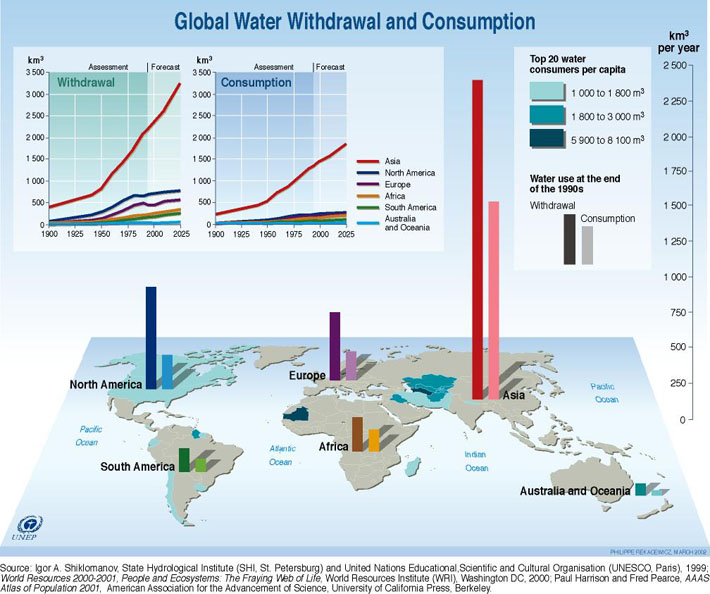
OVERVIEW: THE NECESSITY OF PAYING ATTENTION TO WATER
Obviously, I’m not breaking news by pointing out that that humanity has always been united in its ceaseless quest for sustainable food supplies and a sufficient volume of potable water. Combine universal need with limited supply, however, and “united” doesn’t last long . . . It’s a near historical certainty that the earliest conflicts among homo sapiens sapiens were spawned by struggles to control scarce resources. Tens of thousands of years may have passed, but much less has changed than many investors imagine. Understanding the history and current state of global water supply competition is directly relevant to investing – and growing in relative importance.
A brief glance at maps of the ancient world’s most advanced civilizations (e.g., those that developed early systems of government, writing, agriculture, bronze-age technology, standing armies and agriculture) present a clear correlation between relative development and water-rich geography (The Nile Delta and the swath of land sandwiched between the Yangtze and Yellow Rivers would be two of the clearest examples). Both ancient Egypt and ancient China (along with a host of other similarly situated cultures) literally surged ahead of competitors – despite near constant attacks from nomadic invaders. In sum, the ability to replenish food and water ultimately accelerates societal diversification and promotes technological superiority. The result? Power – in every sense of the word.

The fundamentals of food and water not only continue to drive our planet’s political, economic, social and cultural dynamics but – due to increased population and the many positive and negative externalities caused by several hundred years of exponential technological advancement, water supply, if anything, plays a LARGER role now than during antiquity. Consider the following observation from a recent New York Times article explaining the present Chinese government’s profound concerns about the interrelationship between air pollution and dwindling water supplies:
As the NYT piece goes on to address, the ramifications are enormous – not only for China’s ability to maintain its own societal stability (and high rates of growth), but also for China’s less-developed neighbors who have quickly learned that environmental pollution doesn’t discriminate. Whether one is thinking about island nations that could literally disappear as a result of rising sea levels or threatened third world water supplies (a combination of indigenous growth and the behavior of larger economies), how the world’s water supply is distributed has already become one of the 21st century’s most important (and complicated) trends to follow.

The Smart Investor’s Perspective
While food and water issues are often merely assumed to be a focus for governments and various NGOs (environmental organizations, etc.), it’s past time that investors started more actively thinking about how crises, like those being experienced by China, also play a major role influencing macro and micro economic decision-making. It’s surely no exaggeration to suggest that investors who choose to ignore water during their investment evaluations will eventually (or immediately…) begin making serious errors of judgment. PERIOD. Yes – Water really does matter THAT MUCH.

A few Opening Thoughts on Where to Focus:
- Less water (as a general rule) leads to higher agricultural commodity prices, higher farmland prices and higher food prices. This DOES NOT mean one should automatically view water shortages as an arbitrage opportunity – but rather that scarcity is a basic fact of life, ignored at one’s peril. Price shifts in these sectors can be enormous and sudden – investors looking the other way are voluntarily inviting unacceptable risk and likely missing out on at least certain types of opportunities. [I recently addressed some of this in an article for the website FoodPolicy.US, available at this link]
- As noted, water scarcity also causes social and political instability. After all, an overwhelming majority of the world’s revolutions can ultimately be traced back to an unacceptable disparity in basic necessities. That’s one reason the “water scarcity = arbitrage” thesis is often profoundly misleading. Investing in areas undergoing negative water issues presents countless risks each of which should be careful evaluated.
- To the extent investors do seek to capitalize on markets directly affected by water supply, practicing some version of a long-short strategy is likely advisable. Different types of investments will not only respond differently but often with unusually powerful volatility. Betting everything on “red” or “black” manifests a level of certainty that simply fails to correspond with this market’s actual levels of risk.
- The emergence of water focused Exchange Traded Funds is another point of entry that investors should be carefully considering – especially those looking for a piece of the action but lacking the time and resources to perform hardcore due diligence. One great example of the breathtaking diversity of potential water-oriented “investment plays” can be found at the Powershare Water Resources Portfolio or “PHO.” Also note the chart showing the relative performance of various “water indices” vs. the broader markets. The ISE Water Index, for example, out-performed the S&P 500 in 2012 and is on track to do so even more substantially in 2013.
- Water issues should also be evaluated when looking at specific stocks – e.g., not only when creating a water-oriented portfolio strategy. An analysis in the November 7 issue of the Wall Street Journal offered the following example: “Nestle Chief Executive Officer Paul Bulcke has used his keynote speech at the annual City Food Lecture in the United Kingdom to warn the food industry that water scarcity is one of the greatest threats it faces.” Hence, even if one theoretically had tons of traditional reasons for viewing Nestle as a great investment, disregarding water might be a serious mistake. It’s not every day a company’s CEO literally yells out that sort of negative commentary about his own company’s future prospects . . .
- An in-depth study recently authored by a diverse array of UNESCO-sponsored thought leaders has identified a long and useful list of specifics that all prudent investors should be thinking about: “Rising demand for food caused by growing populations and shifting diets, production shortfall in some countries, increased costs for key agricultural inputs such as fertilizers (driven in turn by energy costs), bioenergy-related incentives in some countries and possible financial speculation have all contributed to the steep rises in food prices.” The report is 100% worth reading in its entirety or – at a minimum – paging through. Great source material for factual background.
- There’s a lot of truth behind the cliche that in every crisis there is opportunity. What’s crucial here is remembering that not all of this opportunity will flow from price fluctuations. It seems logical, for example, that demand for efficient, environmentally safe and less expensive purification and desalination systems is likely to rise substantially over the next decades – consequently a fascinating water-related investment theme. One can imagine numerous other examples ranging from the computers and software that manage municipal water supplies to preparing for the threat of cyber-attacks aimed at disabling such systems.
Without doubt, it’s fair to say that global water supply has now joined the list of top-tier financial indicators. Attention must be paid by investors who want to do well, investors who hope to do good AND investors wise enough to realize this is one area where both of those goals are really two sides of the same coin.

